Population Distributions of Age Groups and Their Influencing Factors Based on Mobile Phone Location Data: A Case Study of Beijing, China
Abstract
1. Introduction
2. Study Area and Datasets
2.1. Study Area
2.2. Datasets
2.2.1. Mobile Phone Signaling Data
2.2.2. POI Data
2.2.3. Population Census Data
3. Method of Gridding and Validation
3.1. Reconstruction of the Spatiotemporal Location
3.2. Computation of the Grid Population
3.3. Validation of the Mobile Location Data Using Population Census Data
4. Population Distribution Patterns in Space and Time
4.1. Spatiotemporal Distribution Characteristics
4.2. Spatiotemporal Aggregation
5. Analysis of the Factors Influencing the Population Distribution in Space and Time
6. Evaluation Site Selection of Coffee Shops in Beijing
7. Conclusions and Discussions
Author Contributions
Funding
Acknowledgments
Conflicts of Interest
References
- Guo, S.; Song, C.; Pei, T.; Liu, Y.; Ma, T.; Du, Y.; Chen, J.; Fan, Z.; Tang, X.; Peng, Y. Accessibility to urban parks for elderly residents: Perspectives from mobile phone data. Landsc. Urban Plan. 2019, 191, 103642. [Google Scholar] [CrossRef]
- Reyes, M.; Páez, A.; Morency, C. Walking accessibility to urban parks by children: A case study of Montreal. Landsc. Urban Plan. 2014, 125, 38–47. [Google Scholar] [CrossRef]
- Mokrysz, S. Consumer preferences and behaviour on the coffee market in Poland. Forum Sci. Oecon. 2016, 4, 91–108. [Google Scholar]
- Sugiyama, T.; Thompson, C.W. Associations between characteristics of neighbourhood open space and older people’s walking. Urban For. Urban Green. 2008, 7, 41–51. [Google Scholar] [CrossRef]
- Wu, S.-S.; Qiu, X.; Wang, L. Population Estimation Methods in GIS and Remote Sensing: A Review. Mapp. Sci. Remote Sens. 2005, 42, 80–96. [Google Scholar] [CrossRef]
- Deichmann, U.; Balk, D.; Yetman, G. Transforming Population Data for Interdisciplinary Usages: From Census to Grid. In Population Health Metrics-Popul Health Metrics; Center for International Earth Science Information Network: Washington, DC, USA, 2001. [Google Scholar]
- Balk, D.; Yetman, G. The Global Distribution of Population: Evaluating the Gains in Resolution Refinement; Center for International Earth Science Information Network (CIESIN), Columbia University: New York, NY, USA, 2004. [Google Scholar]
- Balk, D.; Deichmann, U.; Yetman, G.; Pozzi, F.; Hay, S.; Nelson, A. Determining global population distribution: Methods, applications and data. Adv. Parasitol. 2006, 62, 119–156. [Google Scholar]
- Jia, P.; Qiu, Y.; Gaughan, A.E. A fine-scale spatial population distribution on the high-resolution gridded population surface and application in Alachua County, Florida. Appl. Geogr. 2014, 50, 99–107. [Google Scholar] [CrossRef]
- Reed, F.; Gaughan, A.; Stevens, F.; Yetman, G.; Sorichetta, A.; Tatem, A. Gridded population maps informed by different built settlement products. Data 2018, 3, 33. [Google Scholar] [CrossRef]
- Bakillah, M.; Liang, S.; Mobasheri, A.; Jokar Arsanjani, J.; Zipf, A. Fine-resolution population mapping using OpenStreetMap points-of-interest. Int. J. Geogr. Inf. Sci. 2014, 28, 1940–1963. [Google Scholar] [CrossRef]
- Stevens, F.R.; Gaughan, A.E.; Linard, C.; Tatem, A.J. Disaggregating census data for population mapping using random forests with remotely-sensed and ancillary data. PLoS ONE 2015, 10, e0107042. [Google Scholar] [CrossRef]
- Pei, T.; Sobolevsky, S.; Ratti, C.; Shaw, S.-L.; Li, T.; Zhou, C. A new insight into land use classification based on aggregated mobile phone data. Int. J. Geogr. Inf. Sci. 2014, 28, 1988–2007. [Google Scholar] [CrossRef]
- Agard, B.; Morency, C.; Trépanier, M. Mining public transport user behaviour from smart card data. IFAC Proc. Vol. 2006, 39, 399–404. [Google Scholar] [CrossRef]
- Meneses, F.; Moreira, A. Large scale movement analysis from WiFi based location data. In Proceedings of the 2012 International Conference on Indoor Positioning and Indoor Navigation (IPIN), Sydney, Australia, 13–15 November 2012; pp. 1–9. [Google Scholar]
- Yuan, J.; Zheng, Y.; Zhang, C.; Xie, W.; Xie, X.; Sun, G.; Huang, Y. T-drive: Driving directions based on taxi trajectories. In Proceedings of the 18th SIGSPATIAL International Conference on Advances in Geographic Information Systems, San Jose, CA, USA, 2–5 November 2010; pp. 99–108. [Google Scholar]
- Liu, Y.; Liu, X.; Gao, S.; Gong, L.; Kang, C.; Zhi, Y.; Chi, G.; Shi, L. Social sensing: A new approach to understanding our socioeconomic environments. Ann. Assoc. Am. Geogr. 2015, 105, 512–530. [Google Scholar] [CrossRef]
- Yue, Y.; Lan, T.; Yeh, A.G.O.; Li, Q.Q. Zooming into individuals to understand the collective: A review of trajectory-based travel behaviour studies. Travel Behav. Soc. 2014, 1, 69–78. [Google Scholar] [CrossRef]
- Xu, F.; Zhang, P.; Li, Y. Context-aware real-time population estimation for metropolis. In Proceedings of the 2016 ACM International Joint Conference on Pervasive and Ubiquitous Computing, Heidelberg, Germany, 12–16 Sepetmber 2016; pp. 1064–1075. [Google Scholar]
- Candia, J.; González, M.C.; Wang, P.; Schoenharl, T.; Madey, G.; Barabási, A.-L. Uncovering individual and collective human dynamics from mobile phone records. J. Phys. A Math. Theor. 2008, 41, 224015. [Google Scholar] [CrossRef]
- Chen, J.; Pei, T.; Shaw, S.-L.; Lu, F.; Li, M.; Cheng, S.; Liu, X.; Zhang, H. Fine-grained prediction of urban population using mobile phone location data. Int. J. Geogr. Inf. Sci. 2018, 32, 1770–1786. [Google Scholar] [CrossRef]
- Kang, C.; Liu, Y.; Ma, X.; Wu, L. Towards Estimating Urban Population Distributions from Mobile Call Data. J. Urban Technol. 2012, 19, 3–21. [Google Scholar] [CrossRef]
- Ratti, C.; Pulselli, R.M.; Williams, S.; Frenchman, D. Mobile Landscapes: Using location data from cell phones for urban analysis. Environ. Plan. B Plan. Des. 2006, 33, 727–748. [Google Scholar] [CrossRef]
- Reades, J.; Calabrese, F.; Ratti, C. Eigenplaces: Analysing cities using the space-time structure of the mobile phone network. Environ. Plan. B Plan. Des. 2009, 36, 824–836. [Google Scholar] [CrossRef]
- Krings, G.; Calabrese, F.; Ratti, C.; Blondel, V.D. Urban gravity: A model for inter-city telecommunication flows. J. Stat. Mech. Theory Exp. 2009, 2009, L07003. [Google Scholar] [CrossRef]
- Pierre, D.; Catherine, L.; Samuel, M.; Marius, G.; Stevens, F.R.; Gaughan, A.E.; Blondel, V.D.; Tatem, A.J. Dynamic population mapping using mobile phone data. Proc. Natl. Acad. Sci. USA 2014, 111, 15888–15893. [Google Scholar]
- Liu, Z.; Ma, T.; Du, Y.; Pei, T.; Yi, J.; Peng, H. Mapping hourly dynamics of urban population using trajectories reconstructed from mobile phone records. Trans. GIS 2018, 22, 494–513. [Google Scholar] [CrossRef]
- Kwan, M.P. Gender differences in space-time constraints. Area 2000, 32, 145–156. [Google Scholar] [CrossRef]
- Zhou, S.; Yang, L.; Deng, L. The Spatial-Temporal Pattern of People’s Daily Activities and Transportation Demand Analysis-A Case Study of Guangzhou, China. In Proceedings of the 2010 International Conference on Management and Service Science, Wuhan, China, 24–26 August 2010; pp. 1–4. [Google Scholar]
- Dai, D.; Zhou, C.; Ye, C. Spatial-temporal characteristics and factors influencing commuting activities of middle-class residents in Guangzhou City, China. Chin. Geogr. Sci. 2016, 26, 410–428. [Google Scholar] [CrossRef]
- Plotnikoff, R.C.; Mayhew, A.; Birkett, N.; Loucaides, C.A.; Fodor, G. Age, gender, and urban-rural differences in the correlates of physical activity. Prev. Med. 2004, 39, 1115–1125. [Google Scholar] [CrossRef] [PubMed]
- Van Tuyckom, C.; Scheerder, J.; Bracke, P. Gender and age inequalities in regular sports participation: A cross-national study of 25 European countries. J. Sports Sci. 2010, 28, 1077–1084. [Google Scholar] [CrossRef] [PubMed]
- Karagel, D.Ü. The distribution of elderly population in Turkey and the factors effecting this distribution. Int. J. Soc. Sci. Hum. Stud. 2011, 3, 59–69. [Google Scholar]
- Zhou, J.; Chai, Y. Research progress on spatial behaviors of the elderly in China. Prog. Geogr. 2013, 32, 722–732. [Google Scholar]
- Zhou, S.; Xie, M.; Kwan, M.-P. Ageing in place and ageing with migration in the transitional context of urban China: A case study of ageing communities in Guangzhou. Habitat Int. 2015, 49, 177–186. [Google Scholar] [CrossRef]
- Atkins, M.T.; Tonts, M. Exploring Cities through a Population Ageing Matrix: A spatial and temporal analysis of older adult population trends in Perth, Australia. Aust. Geogr. 2016, 47, 65–87. [Google Scholar] [CrossRef]
- Scheiner, J.; Huber, O.; Lohmüller, S. Children’s mode choice for trips to primary school: A case study in German suburbia. Travel Behav. Soc. 2019, 15, 15–27. [Google Scholar] [CrossRef]
- Yoon, S.Y.; Doudnikoff, M.; Goulias, K.G. Spatial analysis of propensity to escort children to school in southern California. Transp. Res. Rec. 2011, 2230, 132–142. [Google Scholar] [CrossRef]
- Sidharthan, R.; Bhat, C.R.; Pendyala, R.M.; Goulias, K.G. Model for children’s school travel mode choice: Accounting for effects of spatial and social interaction. Transp. Res. Rec. 2011, 2213, 78–86. [Google Scholar] [CrossRef]
- Yuan, Y.; Raubal, M.; Liu, Y. Correlating mobile phone usage and travel behavior—A case study of Harbin, China. Comput. Environ. Urban Syst. 2012, 36, 118–130. [Google Scholar] [CrossRef]
- Xu, Y.; Shaw, S.-L.; Lu, F.; Chen, J.; Li, Q. Uncovering the relationships between phone communication activities and spatiotemporal distribution of mobile phone users. In Human Dynamics Research in Smart and Connected Communities; Springer: Berlin/Heidelberg, Germany, 2018; pp. 41–65. [Google Scholar]
- Fan, Z.; Tao, P.; Ma, T.; Du, Y.; Song, C.; Zhang, L.; Zhou, C. Estimation of urban crowd flux based on mobile phone location data: A case study of Beijing, China. Comput. Environ. Urban Syst. 2018, 69, 114–123. [Google Scholar] [CrossRef]
- Kang, C.; Sobolevsky, S.; Liu, Y.; Ratti, C. Exploring human movements in Singapore: A comparative analysis based on mobile phone and taxicab usages. In Proceedings of the 2nd ACM SIGKDD International Workshop on Urban Computing, Chicago, IL, USA, 11 August 2013; p. 1. [Google Scholar]
- Xu, Y.; Shaw, S.-L.; Zhao, Z.; Yin, L.; Lu, F.; Chen, J.; Fang, Z.; Li, Q. Another tale of two cities: Understanding human activity space using actively tracked cellphone location data. Ann. Am. Assoc. Geogr. 2016, 106, 489–502. [Google Scholar]
- Yang, X.; Fang, Z.; Yang, X.; Shaw, S.L.; Zhao, Z.; Ling, Y.; Tao, Z.; Lin, Y. Understanding Spatiotemporal Patterns of Human Convergence and Divergence Using Mobile Phone Location Data. ISPRS Int. J. Geo-Inf. 2016, 5, 177. [Google Scholar] [CrossRef]
- Moran, P.A. Notes on continuous stochastic phenomena. Biometrika 1950, 37, 17–23. [Google Scholar] [CrossRef]
- Getis, A.; Ord, J.K. The analysis of spatial association by use of distance statistics. In Perspectives on Spatial Data Analysis; Springer: Berlin/Heidelberg, Germany, 2010; pp. 127–145. [Google Scholar]
- Wang, J.F.; Li, X.H.; Christakos, G.; Liao, Y.L.; Zhang, T.; Gu, X.; Zheng, X.Y. Geographical detectors-based health risk assessment and its application in the neural tube defects study of the Heshun Region, China. Int. J. Geogr. Inf. Sci. 2010, 24, 107–127. [Google Scholar] [CrossRef]
- Wang, J.; Xu, C. Geodetector: Principle and prospective. Acta Geogr. Sin. 2017, 72, 116–134. [Google Scholar]
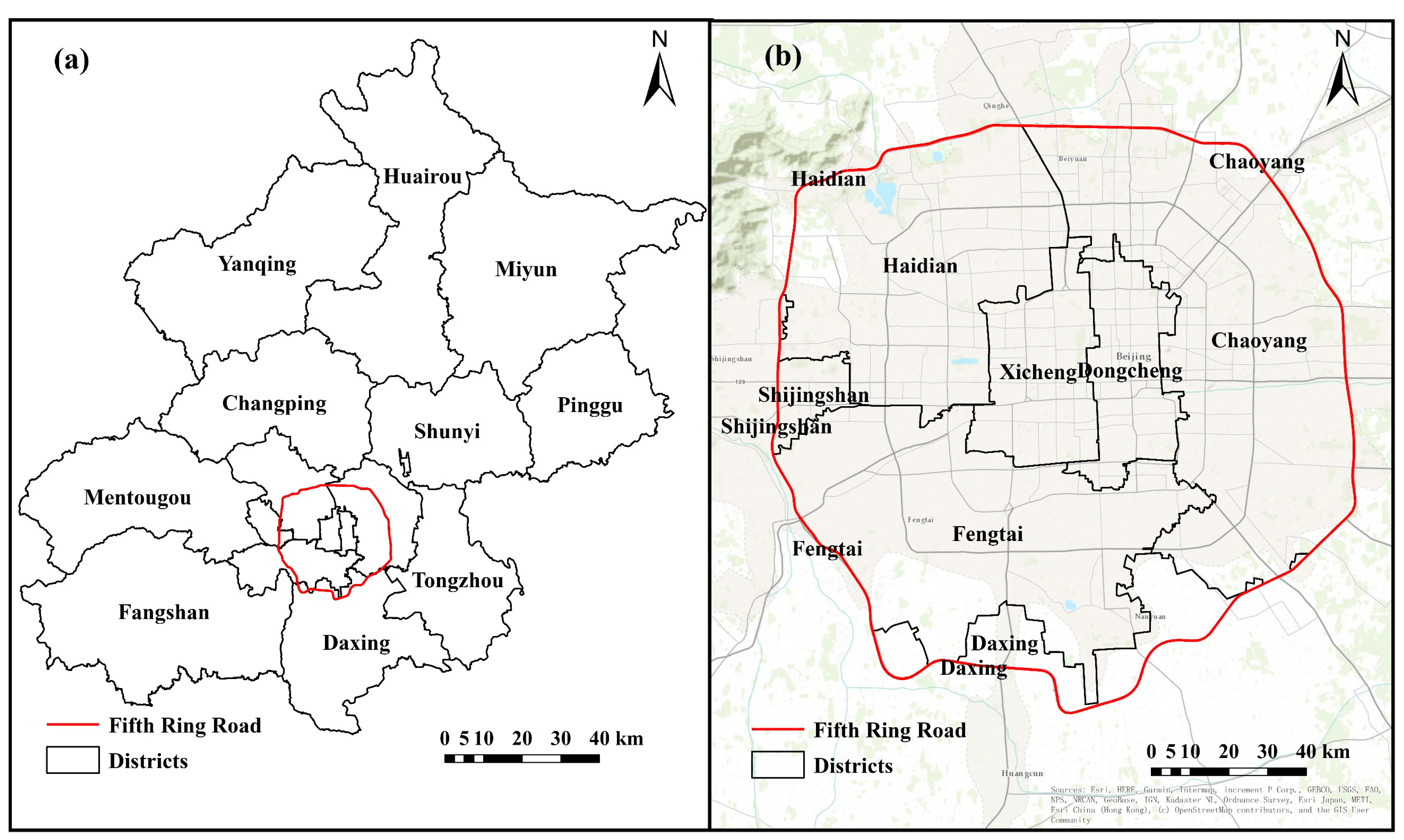
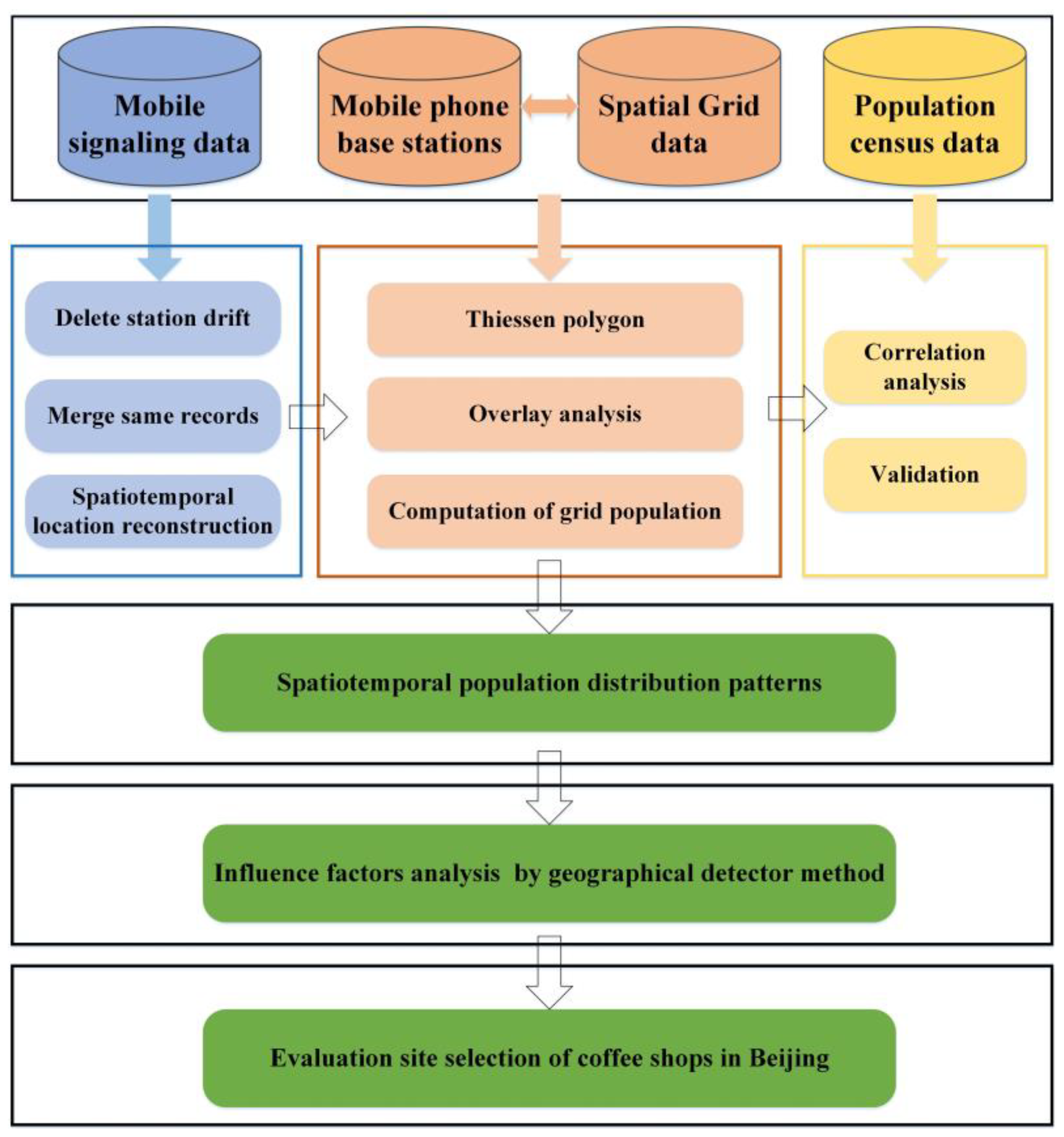
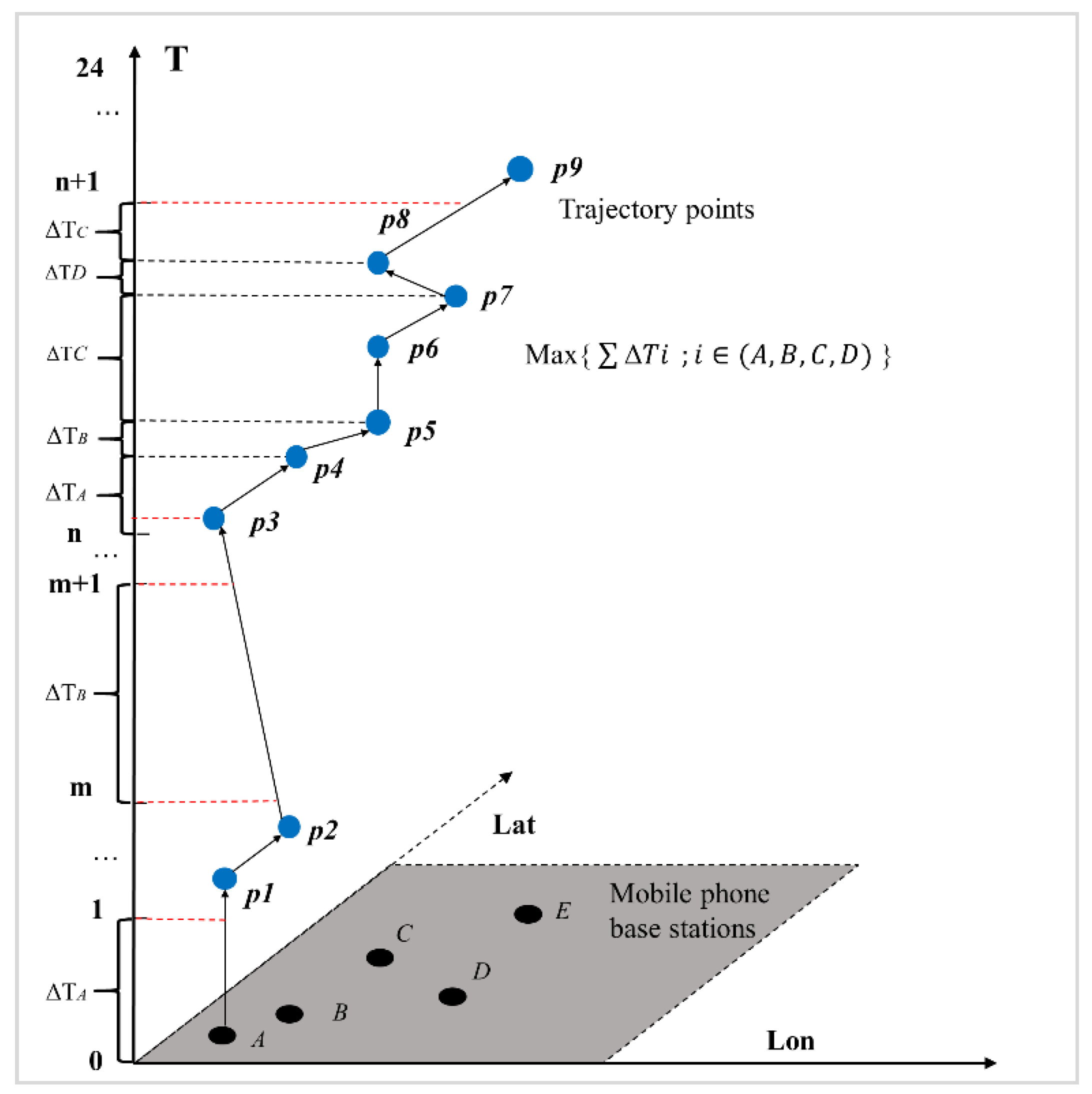
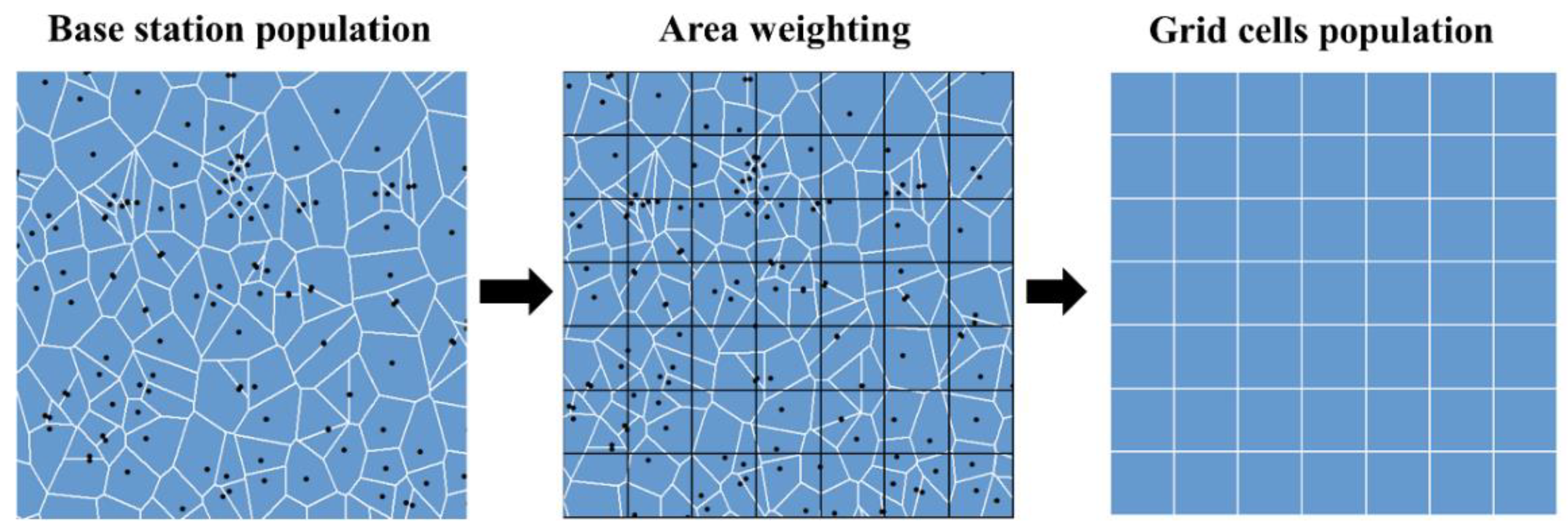
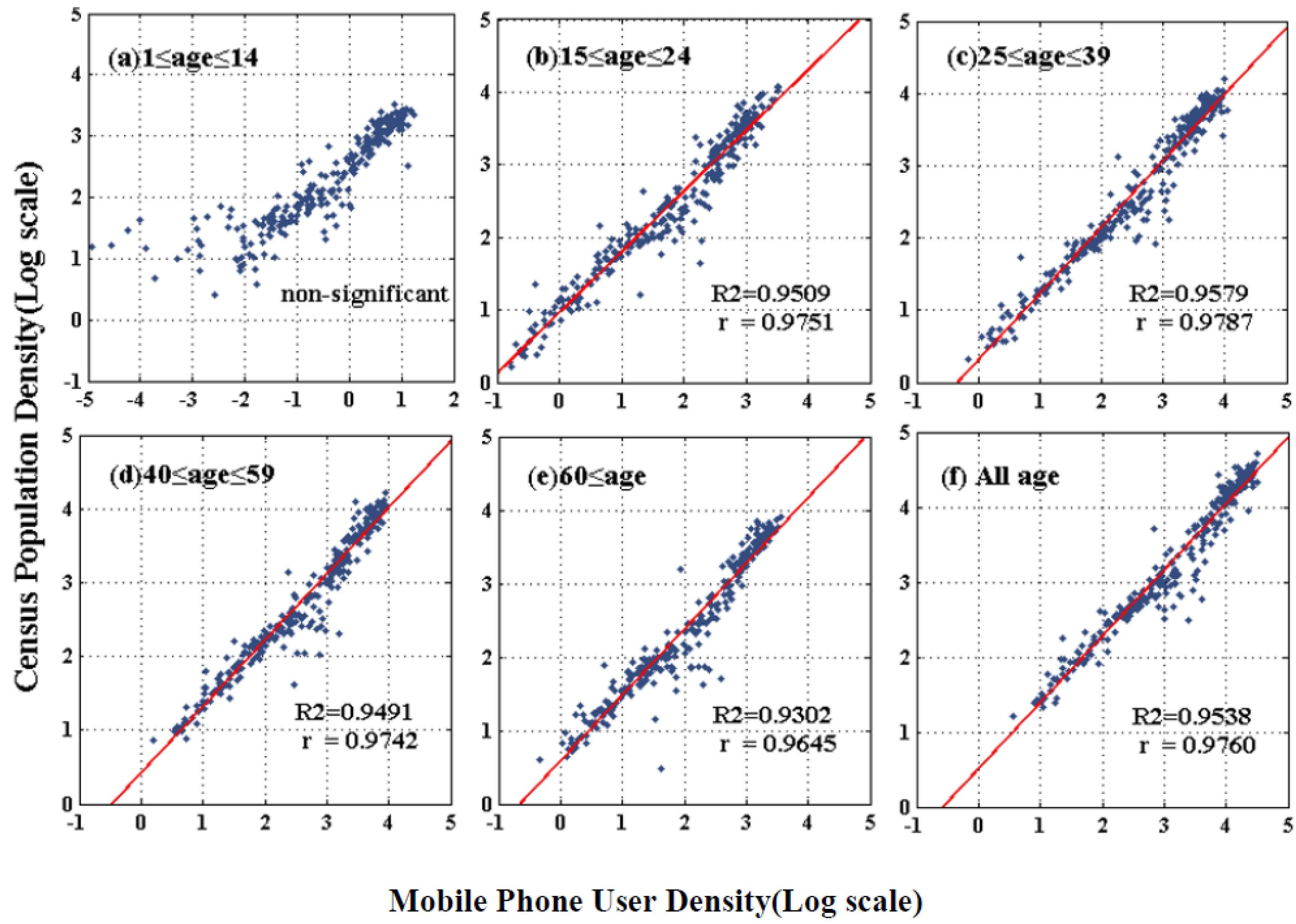
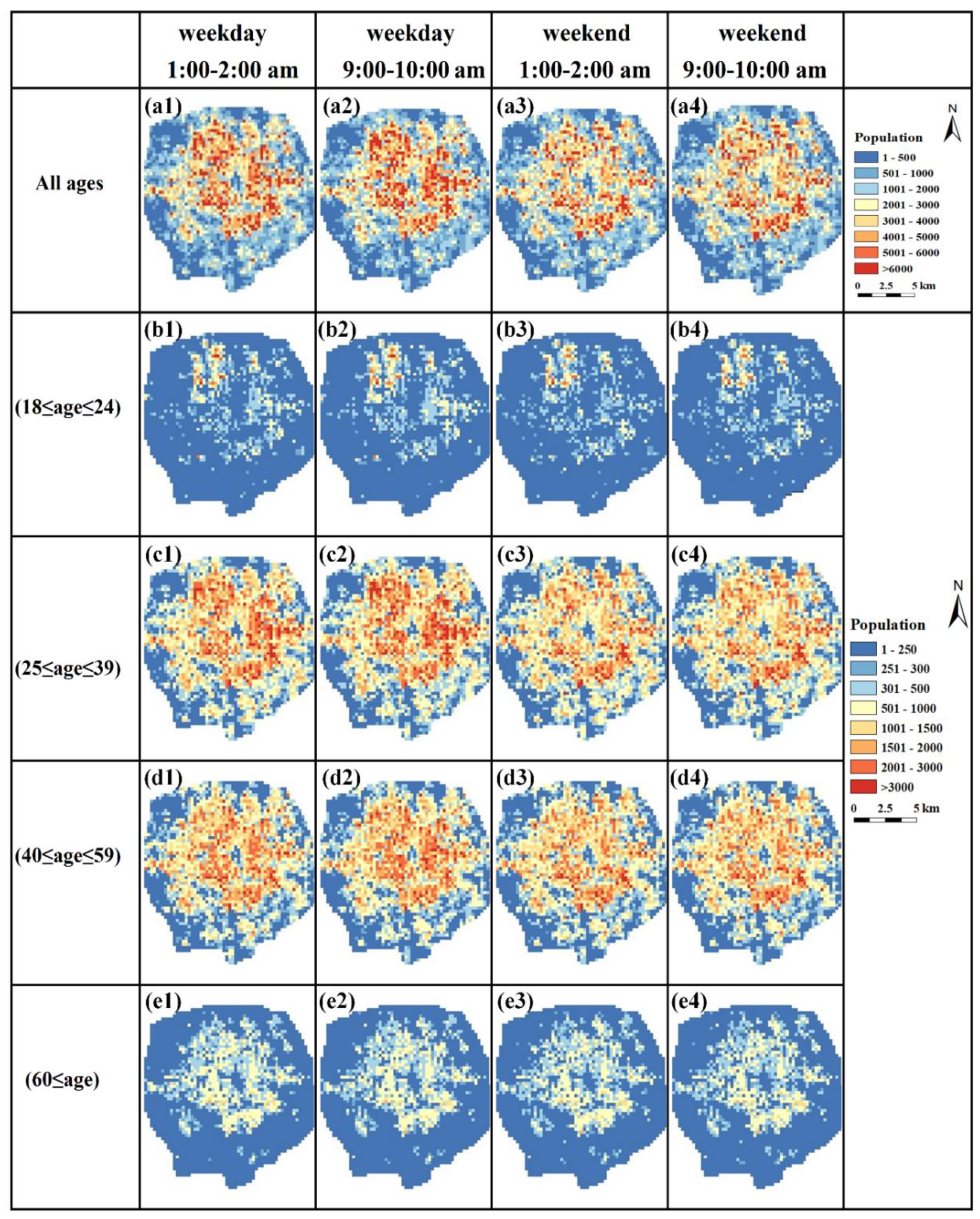
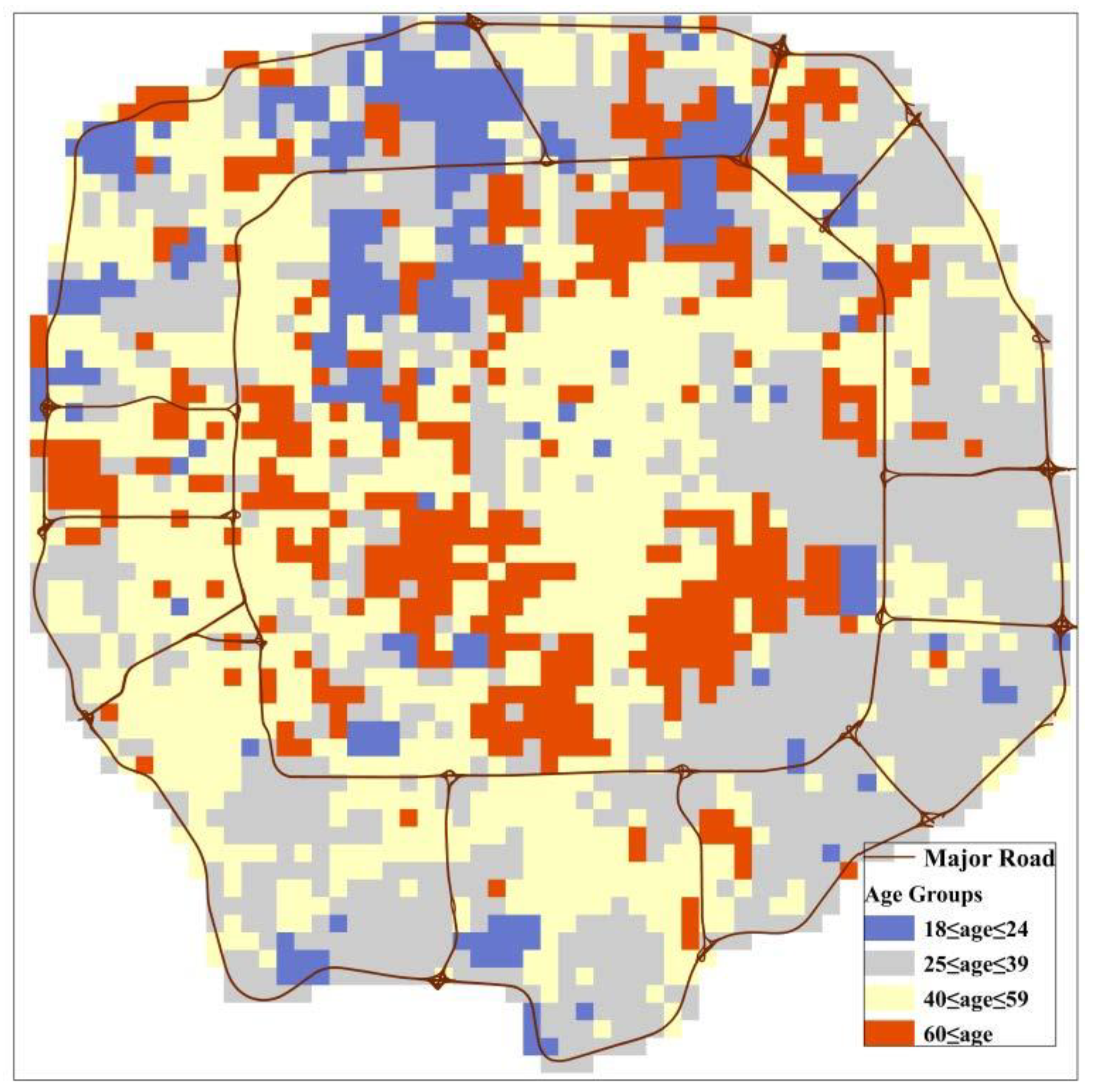
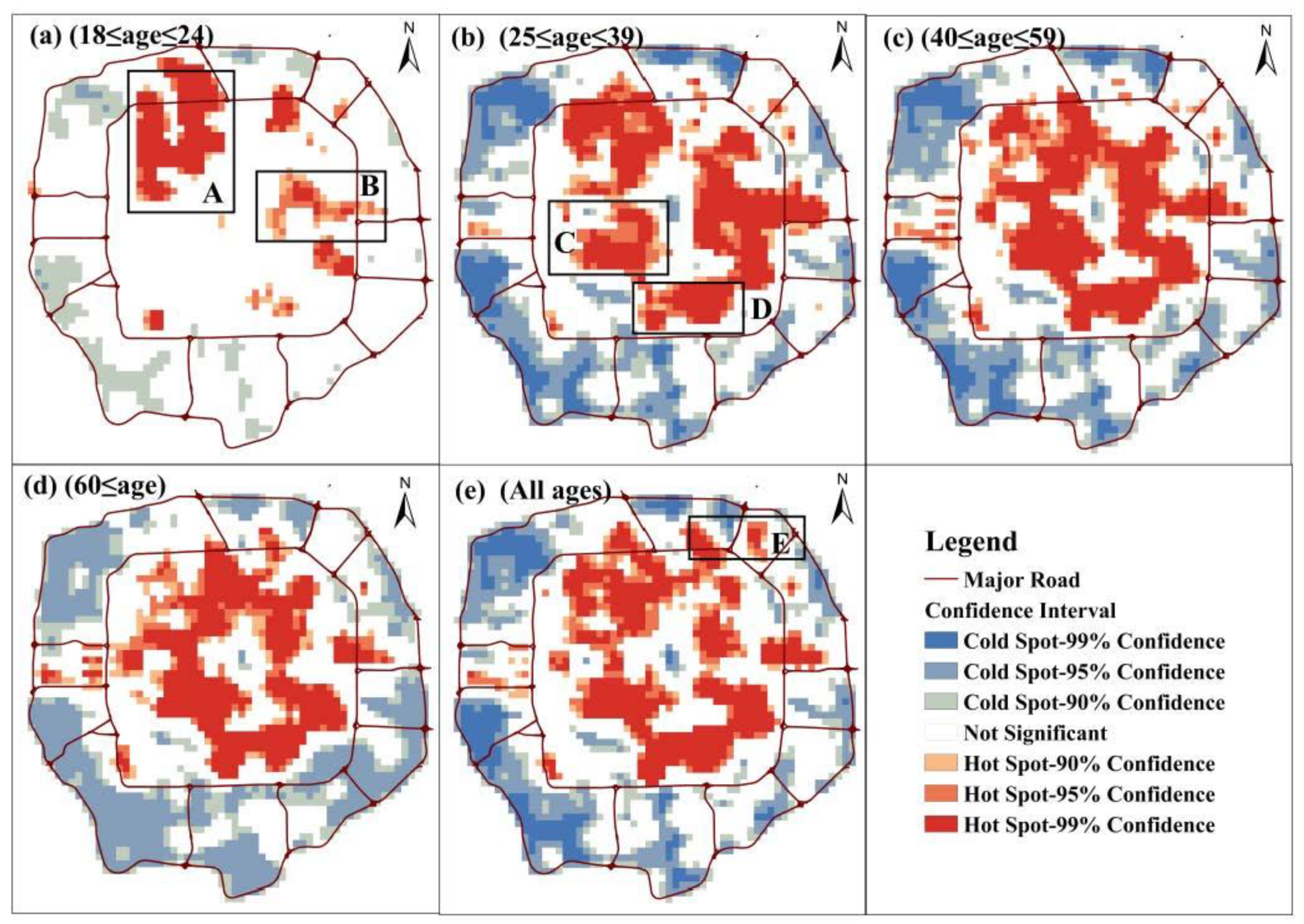

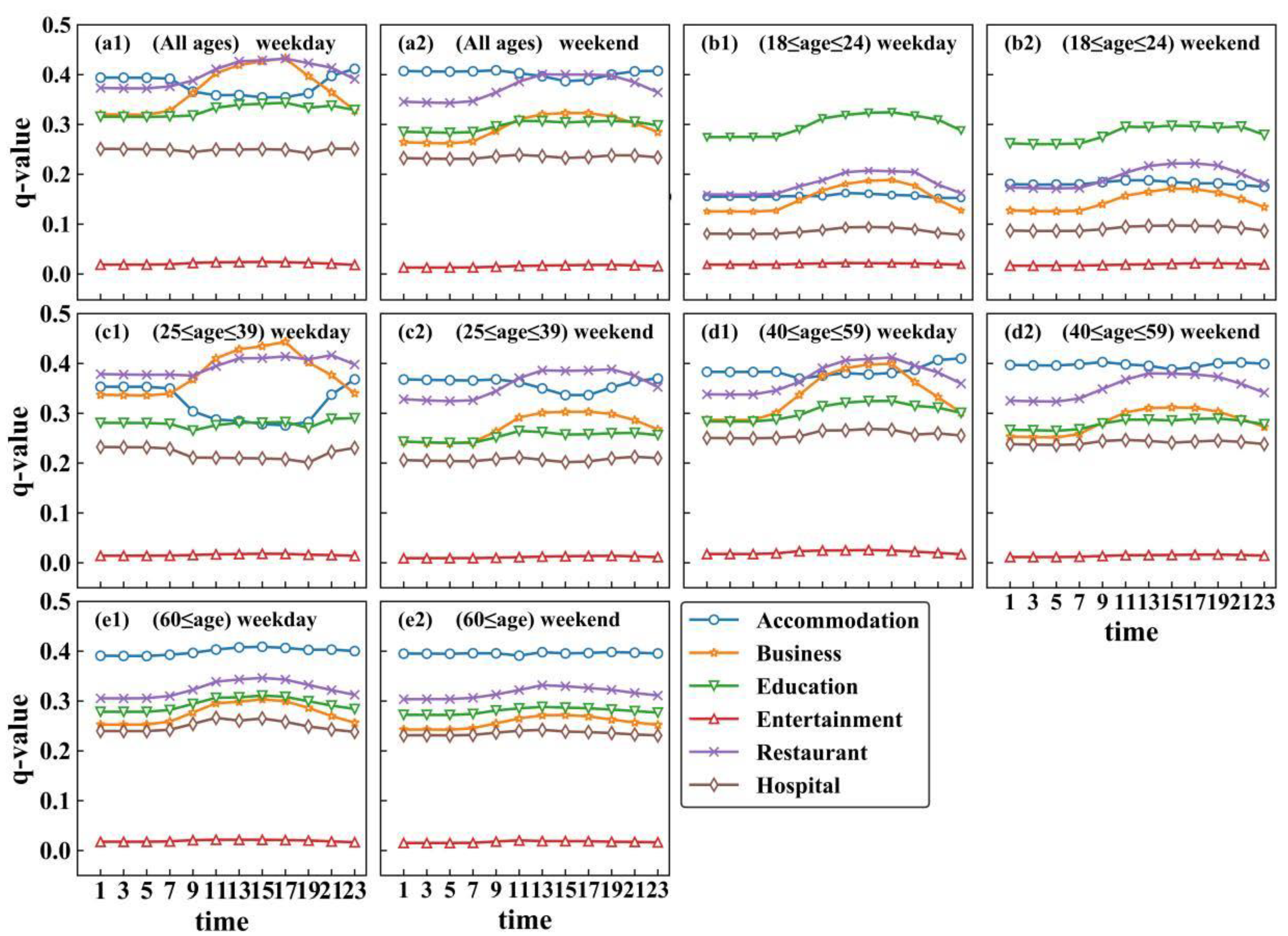
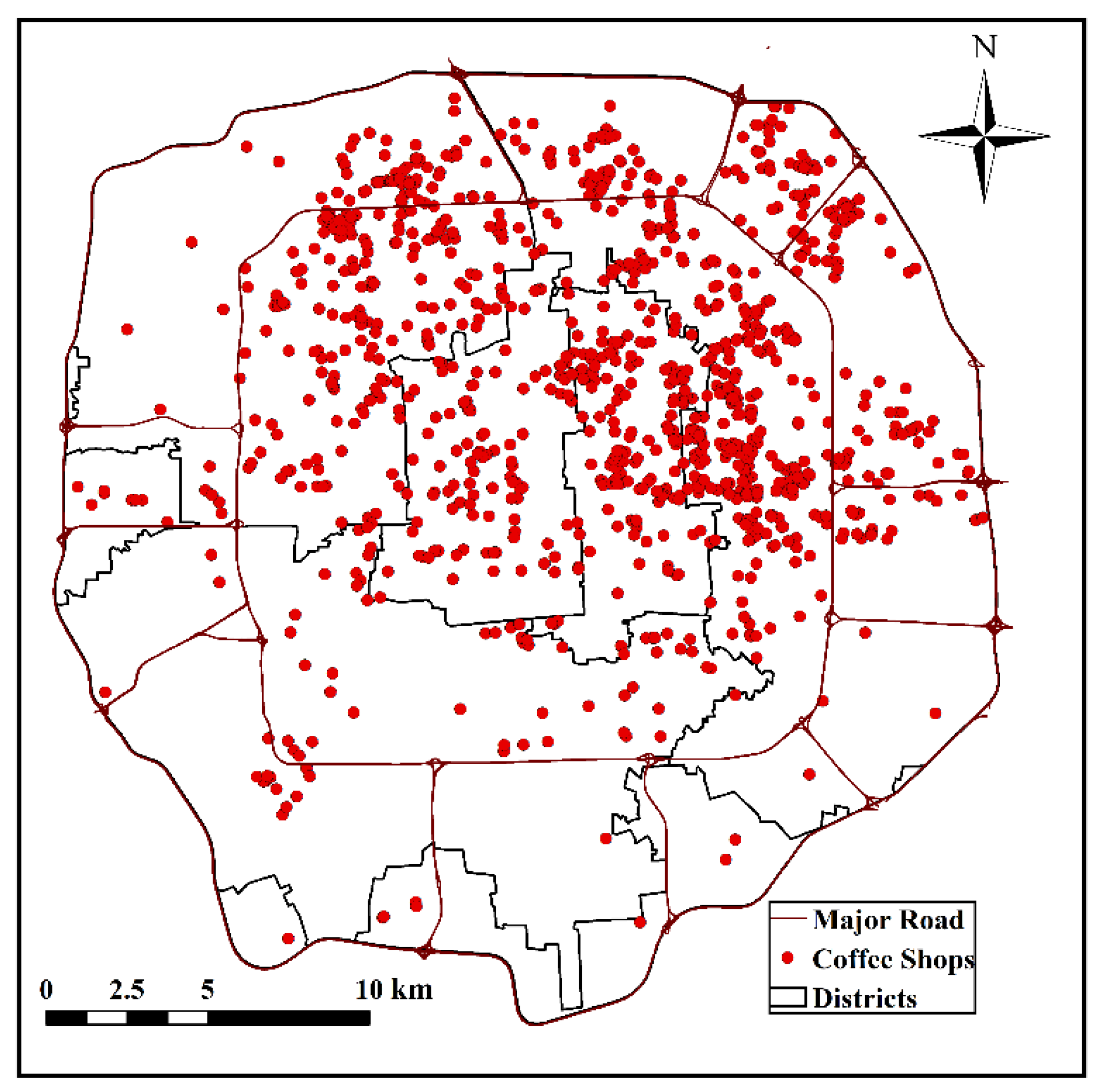


| 18 ≤ Age ≤ 24 | 25 ≤ Age ≤ 39 | 40 ≤ Age ≤ 59 | 60 ≤ Age | |
|---|---|---|---|---|
| 1:00–2:00 a.m. weekday | 0.4988 | 0.5472 | 0.4881 | 0.5331 |
| 1:00–2:00 a.m. weekend | 0.5399 | 0.5851 | 0.5032 | 0.5816 |
| 9:00–10:00 a.m. weekday | 0.5161 | 0.5819 | 0.5001 | 0.5524 |
| 9:00–10:00 a.m. weekend | 0.5480 | 0.6088 | 0.5139 | 0.5949 |
| Spearman Correlation Coefficient | Correct Percentage | |
|---|---|---|
| All age | 0.4418 | 81.10 |
| 18 ≤ age ≤ 24 | 0.4456 | 80.86 |
| 25 ≤ age ≤ 39 | 0.4562 | 81.61 |
| 40 ≤ age ≤ 59 | 0.4124 | 79.75 |
| 60 ≤ age | 0.3706 | 78.82 |
| B | SE | Wald | df | P | EXP (β) | 95% Confidence Interval of EXP (β) | ||
|---|---|---|---|---|---|---|---|---|
| Lower | Upper | |||||||
| 18 ≤ age ≤ 24 | 0.552 | 0.226 | 5.942 | 1 | 0.015 | 1.736 | 1.114 | 2.706 |
| 25 ≤ age ≤ 39 | 1.522 | 0.175 | 75.829 | 1 | 0.000 | 4.582 | 3.253 | 6.454 |
| 40 ≤ age ≤ 59 | −0.621 | 0.302 | 4.226 | 1 | 0.040 | 0.537 | 0.279 | 0.972 |
| 60 ≤ age | 0.137 | 0.538 | 0.065 | 1 | 0.799 | 1.147 | 0.399 | 3.294 |
| constant | −2.656 | 0.092 | 828.299 | 1 | 0.000 | 0.070 | ||
© 2019 by the authors. Licensee MDPI, Basel, Switzerland. This article is an open access article distributed under the terms and conditions of the Creative Commons Attribution (CC BY) license (http://creativecommons.org/licenses/by/4.0/).
Share and Cite
Wang, W.; Pei, T.; Chen, J.; Song, C.; Wang, X.; Shu, H.; Ma, T.; Du, Y. Population Distributions of Age Groups and Their Influencing Factors Based on Mobile Phone Location Data: A Case Study of Beijing, China. Sustainability 2019, 11, 7033. https://doi.org/10.3390/su11247033
Wang W, Pei T, Chen J, Song C, Wang X, Shu H, Ma T, Du Y. Population Distributions of Age Groups and Their Influencing Factors Based on Mobile Phone Location Data: A Case Study of Beijing, China. Sustainability. 2019; 11(24):7033. https://doi.org/10.3390/su11247033
Chicago/Turabian StyleWang, Wenlai, Tao Pei, Jie Chen, Ci Song, Xi Wang, Hua Shu, Ting Ma, and Yunyan Du. 2019. "Population Distributions of Age Groups and Their Influencing Factors Based on Mobile Phone Location Data: A Case Study of Beijing, China" Sustainability 11, no. 24: 7033. https://doi.org/10.3390/su11247033
APA StyleWang, W., Pei, T., Chen, J., Song, C., Wang, X., Shu, H., Ma, T., & Du, Y. (2019). Population Distributions of Age Groups and Their Influencing Factors Based on Mobile Phone Location Data: A Case Study of Beijing, China. Sustainability, 11(24), 7033. https://doi.org/10.3390/su11247033







